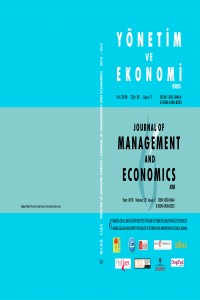Öz
Dışa açıklığın makroekonomik
değişkenlere ve ekonomik büyümeye etkisi yıllardır tartışılmaktadır. Dışa
açıklık yeni ekonomik faaliyetlere ve uzun dönemde üretimin sektörel
bileşiminde değişikliğe neden olabilmektedir. Bunlar, üretim yapısında ve kamu
harcamalarının toplam harcamalar içindeki payında bir değişiklik olabilir.
Küreselleşme ve serbest ticaret, kamu harcamaları ve büyümesini etkilemekte
fakat bu etkinin yönü tartışılmaktadır. Kamu büyüklüğü ve dışa açıklık
arasındaki ilişkiye ilişkin literatürde üç temel hipotez vardır. Bu hipotezler
telafi hipotezi, etkinlik hipotezi ve sanayisizleşme (deindustrialization)
hipotezidir. Telafi hipotezine göre, kamu büyüklüğü ve dışa açıklık arasında
pozitif bir ilişki, etkinlik hipotezine göre negatif bir ilişki vardır.
Sanayisizleşme hipotezine göre ise kamu büyüklüğü ve dışa açıklık arasında
nedensellik ilişkisi yoktur. Bu
çalışmada, kamu büyüklüğü ve dışa açıklık ilişkisi, 1998:1-2016:4 dönemini
kapsayan üç aylık verilerle Türkiye ekonomisi için tahmin edilmiştir.
Değişkenler arasındaki ilişkiler Engle-Granger Koentegrasyon ve Hata Düzeltme
Modeli kullanılarak araştırılmıştır. Ekonometrik analizler, Türkiye
ekonomisinde, kamu büyüklüğü ile dışa açıklık arasında uzun dönemli ilişki ve
kısa dönemde de çift yönlü bir nedensellik ilişkisi olduğunu göstermiştir.
Anahtar Kelimeler
Kamu Büyüklüğü Dışa Açıklık Engle-Granger Koentegrasyon Hata Düzeltme Modeli
Kaynakça
- Abizadeh, S. (2005). An analysis of government expenditure and trade liberalization. Applied Economics, 37 (16), 1881-1884.
- Aidt, T., Jensen, P. (2009). Tax structure, size of government, and the extension of the voting franchise in Western Europe, 1860-1938. International Tax and Public Finance, 16 (3), 362-394.
- Alesina, A., & Perotti, R. (1997). Fiscal adjustments in OECD countries: composition and macroeconomic effects. Staff Papers, 44(2), 210-248.
- Alesina, A., Wacziarg, R. (1998). Openness, country size and government. Journal of Public Economics, 69 (3), 305-321.
- Alvarez, S., Pascual, M., Romero, D. (2003). Protección social, globalizacióny crecimiento económico,. Hacienda Pública española, Monografía, pp. 63-77.
- Aydogus, İ., Topcu, M. (2013). An Investigation of Co-Integration and Causality between Trade Openness and Government Size in Turkey. International Journal of Economics and Financial Issues, Vol. 3, No. 2, pp.319-323.
- Balle F., Vaidya A. (2002). A regional analysis of openness and government size. Appl Econ Lett, 9(5):289–292.
- Benarroch, M, Pandey, M. (2008). Trade openness and government size. Econ Lett 101:157–159.
- Borghi, E. (2008). Trade Openness and Public Expenditure on Labor Market Prices, http://www.etsg.org/ETSG2008/Papers/Borghi.pdf
- Cameron, D. R. (1978). The Expansion of the Public Economy: A Comparative Analysis. American Political Science Review, 72, 237–269.
- Cusack, T. (1997). Partisan politics and public finance: Changes in public spending in the industrialized democracies 1955-1989. Public Choice. 91 (3-4). 375-395 41.
- Dickey, D. A., Fuller, W. A. (1981). Likelihood Ratio Statistics for Autoregressive Time Series with a Unit Root. Econometrica: Journal of the Econometric Society,49(4), 1057-1072.
- Dickey, D. A., Fuller, W. A. (1979). Distribution of the estimators for autoregressive time series with a unit root. Journal of the American Statistical Association, 74(366a), 427-431.
- Dominte, L. (2006). Determinants and Effects of Economic Openness. Analele Stiintifice ale Universitatii Alexandru Ioan Cuza din Iasi, 52/53, s.243-245.
- Dreher, A. (2006). The influence of globalization on taxes and social policy: An empirical analysis for OECD countries. European Journal of Political Economy, 22 (1), 179-201. Dreher, A., Sturm, J.E., Ursprung, H. (2008). The impact of globalization on the composition of government expenditures: Evidence from panel data. Public Choice, 134 (3-4), 263-292.
- Engle, R. F., Yoo, B. S. (1987). Forecasting and Testing in Cointegrated Systems. Journal of Econometrics, 35, 143-159.
- Engle, R. F., Granger, C. W. (1987). Co-integration and Error Correction: Representation, Estimation, and Testing. Econometrica: Journal of the Econometric Society, 55(2), 251-276.
- Epifani, P., Gancia, G. (2009). Openness, Government Size and the terms of Trade. Review of Economic Studies, Vol. 76 (2), pp. 629-668.
- Garrett, G., (2000). Globalization and Government Spending around the World. Studies in Comparative International Development, 35 (4), 3-29.
- Garrett, G., Mitchell, D. (2001). Globalization, government spending and taxation in the OECD. European Journal of Political Research, 39 (2), 145-177.
- Gordon, R.H. (1983). An optimal taxation approach to fiscal federalism. Q J Econ, 98:567–586.
- Granger, C. W. (1969). Investigating Causal Relations by Econometric Models and Cross-Spectral Methods. Econometrica: Journal of the Econometric Society, 37(3), 424-438.
- Granger, C. W. (1988). Some Recent Development in a Concept of Causality. Journal of Econometrics, 39(1), 199-211.
- Iversen, T., Cusack, T. (2000). The Causes of Welfare State Expansion: Deindustrialization or Globalization?. World Politics, 52 (3), 313-349.
- Jin, J., Zou, H. (2002). How does fiscal decentralization affect aggregate, national, and subnational government size?. Journal of Urban Economics, 52 (2), 270-293. MacKinnon, J.G. (1991). Critical Values for Cointegration Tests. (No. 1227), Queen's Economics Department Working Paper.
- Miller, S. M., Russek, F. S. (1990). Co-integration and error-correction models: The temporal causality between government taxes and spending. Southern Economic Journal, 221-229.
- Persson T., Tabellini, G. (1992). The politics of 1992: fiscal policy and European integration. Rev Econ Stud, 59:689–701.
- Potrafke, N. (2009). Did globalization restrict partisan politics? An empirical evaluation of social expenditures in a panel of OECD countries. Public Choice, 140 (1-2), 105-124.
- Rodrik, D. (1998). Why do more open economies have bigger governments, Journal of Political Economy, 106, 997-1032.
- Rodrik, D. (2011). Akıllı Küreselleşme. Çev: Burcu Aksu. Ankara: Efil Yayınevi.
- Ruggie, J.G. (1982). International Regimes, Transactions, and Change: Embedded Liberalism in the Postwar Economic Order, International Organization, 36, 379–415.
- Shelton, C. A. (2007). The size and composition of government expenditure. Journal of Public Economics, 91(11), 2230-2260.
- Tavits, M. (2004). The Size of Government in Majoritarian and Consensus Democracies. Comparative Political Studies, 37 (3), 340-359.
- Wilson, J.D. (1987). Trade, capital mobility and tax competition. J Political Econ 95:835–856.
Ayrıntılar
| Birincil Dil | Türkçe |
|---|---|
| Bölüm | Makaleler |
| Yazarlar | |
| Yayımlanma Tarihi | 14 Ağustos 2018 |
| Yayımlandığı Sayı | Yıl 2018 Cilt: 25 Sayı: 2 |


